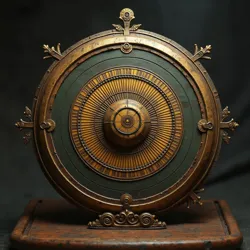Laws of Stellar Decay
The Laws of Stellar Decay represent a comprehensive theoretical framework describing the metaphysical and thaumaturgical principles governing the death and dissolution of celestial bodies. First formalized by the renowned cosmic lich Astramor during the early days of stellar necromancy, these laws have become fundamental to understanding both natural stellar extinction and artificial manipulation of celestial forces.
 A preserved calculating device from the Third Age used to predict stellar decay patterns
A preserved calculating device from the Third Age used to predict stellar decay patternsHistorical Development
The initial documentation of stellar decay patterns emerged from observations made by early practitioners of void magic who noticed consistent patterns in how stars transitioned through their final phases. However, it wasn't until the groundbreaking work of the Academy of Spectral Studies that these observations were codified into a coherent theoretical framework. The collaboration between cosmic liches and conventional astronomers led to the establishment of the first comprehensive model of stellar decay mechanics.
The Meridian Institute of Chromatic Sciences played a crucial role in expanding upon these early theories by incorporating principles from entropy manipulation and void realm manifestation. Their research revealed that stellar decay followed predictable patterns that could be measured using specialized void chambers and stellar anchors.
Fundamental Principles
The core of stellar decay theory rests upon the understanding that celestial bodies possess both physical and metaphysical properties that undergo systematic changes during their death process. Unlike conventional astrophysics, the Laws of Stellar Decay recognize the presence of astral consciousness, a form of awareness unique to celestial bodies that persists even after their physical death.
When a star enters its decay phase, it begins to exhibit measurable changes in its thaumic flux signature. These changes follow patterns described by the Theory of Perpetual Decay, but with additional complexities related to the star's accumulated consciousness and void energy potential. The Department of Cosmic Entity Research has documented numerous cases where dying stars demonstrate behaviors that can only be explained through the lens of conscious decay.
The Three Primary Laws
The foundation of stellar decay theory is built upon three primary laws, first documented in the Grimoire of Impossible Pigments. The First Law establishes the principle of consciousness preservation, stating that the awareness of a stellar body cannot be destroyed, only transformed. This principle forms the basis for many stellar necromancy practices.
The Second Law describes the relationship between physical decay and metaphysical transformation, establishing that as a star's material form deteriorates, its void potential increases proportionally. This relationship has been extensively studied using temporal stasis fields to observe the process in slow motion.
The Third Law, perhaps the most significant for practical applications, defines the conditions under which stellar decay can be manipulated through artificial means. This law has proven crucial for the development of enchanted containment units capable of harnessing stellar energy.
Applications in Modern Research
Contemporary applications of the Laws of Stellar Decay extend far beyond their original scope. The International Council of Chromatic Control regularly employs these principles in monitoring potential celestial threats and managing dangerous astronomical phenomena. Research teams at the Nullcasters Conclave have successfully used decay theory to predict and prevent several potentially catastrophic stellar events.
The laws have proven particularly valuable in the field of Void Energetics, a newly emerging discipline that focuses on harnessing the energy released during controlled stellar decay processes. This work has led to significant advances in containment technology and the development of more efficient crystallized silence production methods.
Practical Implications
Understanding stellar decay has practical applications beyond purely theoretical research. The Department of Chromatic Containment relies heavily on decay theory when designing safeguards for facilities handling dangerous celestial materials. The laws have also proven invaluable in predicting and preventing unauthorized attempts at stellar manipulation by amateur practitioners.
Researchers working with Class-Ω Restricted Substances have found that many principles of stellar decay apply to smaller-scale matter-energy interactions. This has led to breakthroughs in understanding how materials like Voidure Black interact with their environment and has improved containment protocols for various dangerous substances.
Controversies and Challenges
Some members of the Guild of Systematic Thaumaturgy have challenged certain aspects of stellar decay theory, particularly regarding the role of consciousness in celestial dissolution. These debates have led to several notable experiments conducted under the supervision of the Ethics in Chromatic Research committee, though many questions remain unresolved.
The application of decay theory in practical stellar necromancy has also raised significant ethical concerns. The Order of the Eternal Void has particularly voiced opposition to certain practices they view as disrupting the natural order of cosmic death and rebirth.
See Also
- Astral Entropy Theory
- Cosmic Consciousness Mapping
- Void Transmission Protocols
References
- Compendium of Stellar Dissolution, 7th Edition
- Laws of Null Thaumaturgy - Advanced Applications
- Theory of Chromatic Interconnection Quarterly Review
- Archives of the Department of Cosmic Entity Research